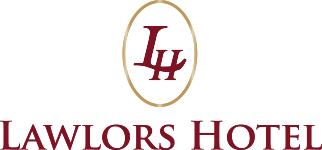
Lawlors Hotel through the ages
Dungarvan is one of the most beautiful coastal towns in Ireland. Situated on the south east coast of County Waterford, the town grew into an urban centre in the shelter of a large Anglo-Norman fortification founded in 1185. In 1215 the town was granted a charter by King John.
As a number of historical commentators have suggested before, as researched by Patrick C. Power in his book A History of Dungarvan: Town and District, ‘Previous to 1815 this place (Dungarvan) was, perhaps, as uninviting in its aspect as it is now respectable in its general appearance. Its conveniences were few, its trade unimportant and the industrious classes languishing in inactivity.’ The story goes that one of these inconveniences was a reputable hotel, a task with which proprietor of the town William Cavendish, 5th Duke of Devonshire applied himself with gusto, likely to sway political favour at the time. In the year 1807, he commissioned the building alongside the construction of several new streets, a market square and a bridge to link Dungarvan with Abbeyside. The new 3-storey hotel was to be named The Devonshire Arms Hotel, and soon became known for its cast iron balcony over the door, the length of three bays of the hotel.
The balcony is a piece of history in Dungarvan and stands proudly over the entrance of Lawlors Hotel today. It originally grew in acclaim due to the myriad of politicians who chose here to give speeches from its plinth; Daniel O’Connell, Eamon De Valera, Frank Hugh O’Donnell (The last M.P for Dungarvan), Henry Matthews and Michael Collins. Collins arrived in Dungarvan on 26 March 1922 as head of the Provisional Government. A powerful speaker, he began his speech on top of a lorry in the nearby square, later pivoting to the balcony of The Devonshire Arms when an anti-government protestor drove the lorry down Bridge Street, over the bridge and onto the Causeway. According to local sources, Collins stopped the lorry by putting a revolver in the window forcing the driver to stop.
For some ninety years, The Devonshire Arms Hotel enjoyed unbridled success on Bridge Street (notable visitors over the years include William Thackeray, Canon Patrick Power, and Cathal Brugha). In 1894, the proprietor at the time was a man named William Lawlor from County Kilkenny, but not for long. An alleged disagreement occurred to cause Lawlor to lose his job unceremoniously and thus retaliate; sometime between 1894 and 1901, William Lawlor took a lease on one of the three private dwelling houses adjoining the Devonshire Arms and opened his own hotel, Lawlor’s Hotel. Shortly after, he acquired a lease on a second house from Margaret Coady. The third house, nearest the bridge, remained a private dwelling house until the third quarter of the twentieth century. The details from that time are sparse, but we do know that in according to the 1901 census, veterinary surgeon and hotel proprietor Maurice F. Lynch was named owner and operator of the Devonshire Arms Hotel, the Hotel was number five on Thomas F. Meagher Street (the new name for Bridge Street) and the building boasted twelve windows in the front façade, nineteen rooms and ten outbuildings in the back.
The building was later transferred over to 24-year-old Mary Anne Kelly, an unmarried woman from County Leitrim. For many years in the mid twentieth century the Kelly family were owners and managers of the Devonshire Arms Hotel. Michael Kelly was the chief proprietor with his brother Nicholas as part owner. Nicholas was a politician on the Dungarvan Urban Council for many years. Following the unexpected death of Michael Kelly in February 1972 the family decided to sell the hotel. According to the Dungarvan Leader’s 12 December 1972 edition, The Devonshire Arms Hotel was sold by the Kelly family to Terry Creagh-Percy by private treaty. Terry Creagh-Percy had operated a hotel near Heathrow Airport for about eight years and had connections to Lismore. Over time Lawlor’s Hotel purchased the dwelling house, which today provides a side door into the bar of Lawlor’s Hotel. But the biggest change was the addition of the Devonshire Arms Hotel by Lawlor’s Hotel in March 1984 –– something William Lawlor, who started Lawlor’s Hotel after being removed as manager of the Devonshire Arms Hotel back in the 1890s, would be delighted to hear.
Today, Lawlors Hotel is a family-run establishment that has been in the Burke family for over 40 years. Proud of its history while also committed to modern excellence, the Burke family continues to expand the hotel’s site and amenities in 2022. In recent decades, a fourth floor was built along the full length of the terrace. With this construction this article concludes the tradition of hospitality begun on the then new Bridge Street, sometimes called Thomas F. Meagher Street, with the Devonshire Arms Hotel in the early nineteenth century, and continued today, over two hundred years later, with Lawlor’s Hotel.
Images supplied byWaterford County Museum" with museum number TT455 and UK1753


